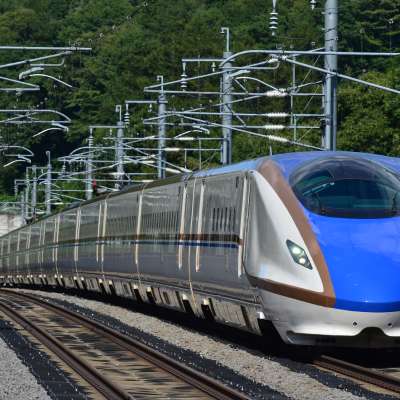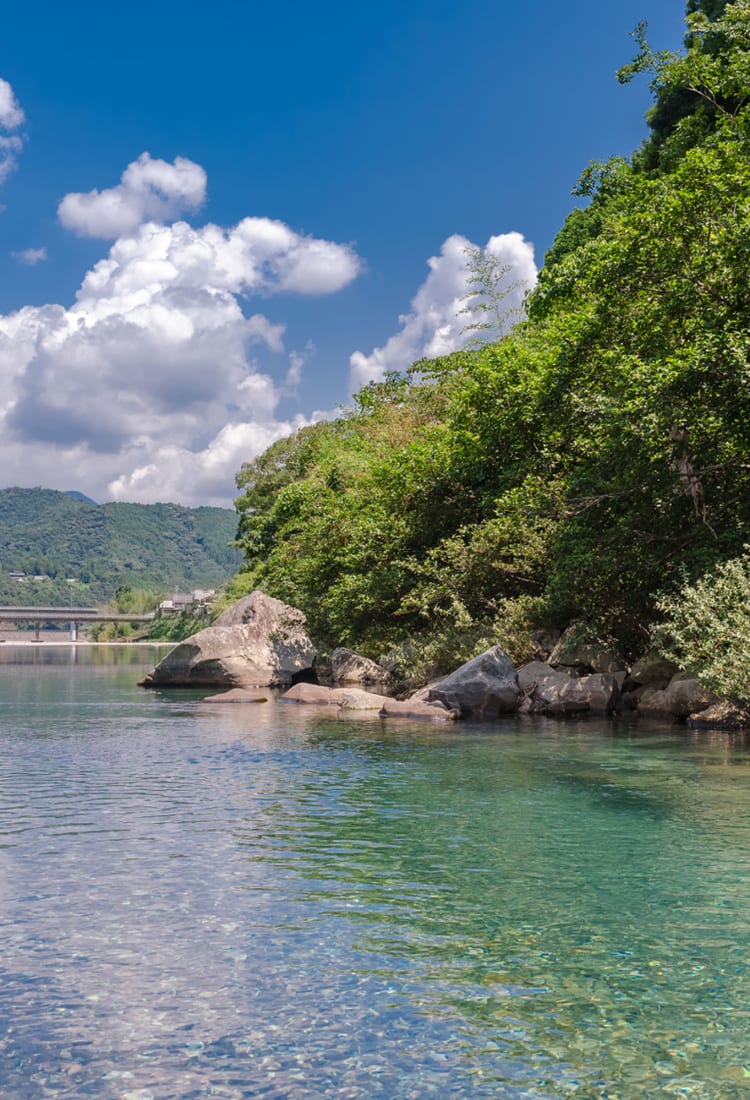
2024.07 From Rivers to Hot Springs: Unique Water Experiences in Japanese National Parks See Japan from a Different Perspective Beyond the Shore
Take A Pilgrimage Along the Tranquil Kumano River

Navigate the sacred Kumano River by kayak.
Yoshino-Kumano National Park spans the Kii Peninsula across Nara, Mie, and Wakayama Prefectures, and encompasses many natural wonders such as mountains, rivers, and beaches. Some of the park’s attractions include Mt. Yoshino, a famous cherry blossom spot, and Kumano Nachi Taisha Shrine, where visitors can find Nachi Waterfall, Japan's tallest waterfall, with an uninterrupted drop of 133 meters.
The Kumano River makes up part of the Kumano Kodo, an ancient pilgrimage network that dates back more than 1,000 years. The Kumano River is the only waterway in the world that is registered as a UNESCO World Heritage Pilgrimage route, and kayaking along the river offers a unique opportunity to experience the landscape from a distinctive vantage point.
Throughout history, the Kumano River has served as a pilgrimage route to two of the three great Kumano shrines. Today, visitors can embark on a river cruise and experience the spirit of these ancient pilgrimages.

Paddle your way through the waters of the Kumano River on a guided kayak tour.
Guided kayaking tours are available for visitors unfamiliar with the river, and some of the best times of year to kayak the Kumano River are during the Japanese spring from March to May or autumn months from September to November when the weather is milder, and the scenery is particularly vibrant.
Kayaking the Kumano River from Hongu to Shingu offers a blend of adventure, spirituality, and natural beauty, making it a memorable way to experience one of Japan's most historic pilgrimage routes.
The Hongu area can be accessed by a one to two-hour bus journey from the Shingu or Kii-Tanabe Station.
Explore Lake Chuzenji’s Seasons from the Water
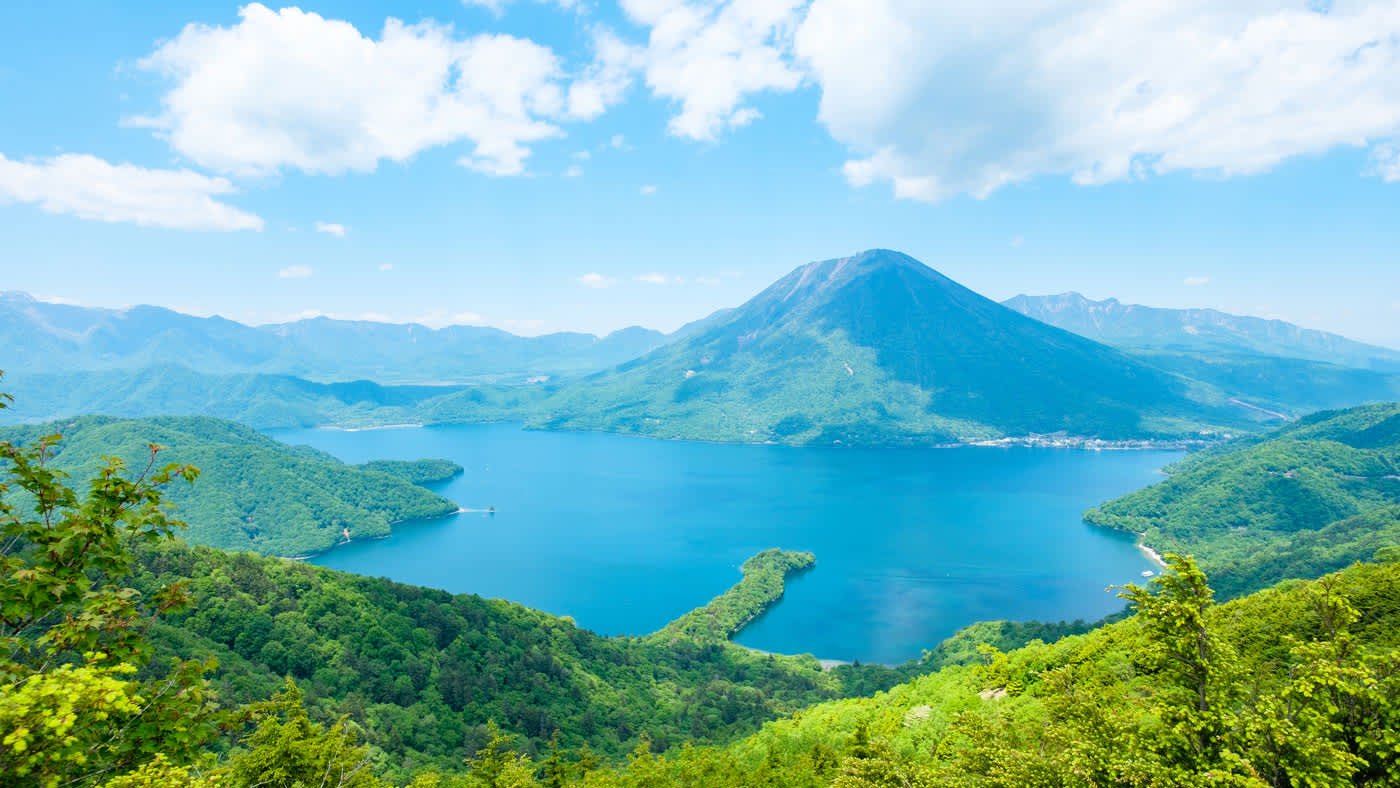
Discovering peaceful Lake Chuzenji in Nikko National Park.
Located just west of Nikko in Tochigi Prefecture, Lake Chuzenji is one of the highest natural lakes in Japan with an altitude of 1,269 meters. The lake spans a circumference of 25 kilometers and reaches a maximum depth of 163 meters. Formed around 20,000 years ago by an eruption from the nearby Mt. Nantai, a stratovolcano within Nikko National Park, Lake Chuzenji has a rich geological history.
During the 19th and 20th centuries, the lake rose to prominence as an international summer resort, attracting foreign embassies to build villas and resorts. Diplomats and their families enjoyed boating and fishing, activities that still remain popular during certain times of the year.
Today, visitors can still admire the British and Italian Embassy Villas Memorial Park along its shores, reflecting the lake's historical significance.
The area around the lake is home to forests, and on the northeastern shore lies Chuzenji Onsen, featuring a small collection of restaurants, shops, and hot springs. The nearby Nikko Natural Science Museum also offers exhibits detailing the area's natural history. On the eastern shore, Chuzenji Temple boasts stunning views and impressive Buddhist artwork.
Lake Chuzenji is especially enchanting from April to November. It begins with the cherry blossom season, followed by the vibrant bloom of azaleas in early May. Later in the year, starting in October, visitors are treated to a spectacular display of autumn foliage, with the colorful leaves beautifully reflected in the lake's serene waters.

Paddling through nature – SUP adventures on Lake Chuzenji.
Stand-up paddleboarding (SUP) on Lake Chuzenji offers a unique way to experience its stunning natural beauty. The lake’s peaceful waters provide the perfect environment for both beginners and experienced paddlers, whilst wetsuit rentals ensure that visitors can enjoy this activity throughout the year, regardless of the season.
Lake Chuzenji can be accessed easily via a bus from either JR Nikko Station or Tobu Nikko Station. The journey time is around 50 minutes.
Discover the Healing Waters and Public Bathhouses of Nozawa Onsen Village

Relaxing in Nozawa Onsen Village's healing waters.
Nozawa Onsen Village is situated in Joshin'etsukogen National Park in Nagano Prefecture, renowned for its dramatic landscapes and a hub for onsen (natural hot springs), encompassing well-known hot spring towns such as Shima Onsen, Manza Onsen, and Kusatsu Onsen, alongside Nozawa Onsen Village.
Nozawa Onsen Village is a small village that sits on the northernmost part of Nagano Prefecture. The village is focused around a collection of inns and hotels at the base of Mt. Kenashi and is considered to be one of Nagano’s premier destinations for winter sports.
However, the real star of Nozawa Onsen Village is its natural hot spring waters, which visitors will find at many of the village’s traditional ryokan (Japanese inns) and hotels.
Nozawa Onsen Village became a popular hot spring town during Japan’s Edo Period (1603–1867) when it was believed that soaking in the alkaline mineral-rich water would help to heal various illnesses. The water is also said to have anti-aging effects and helps to make skin smoother.
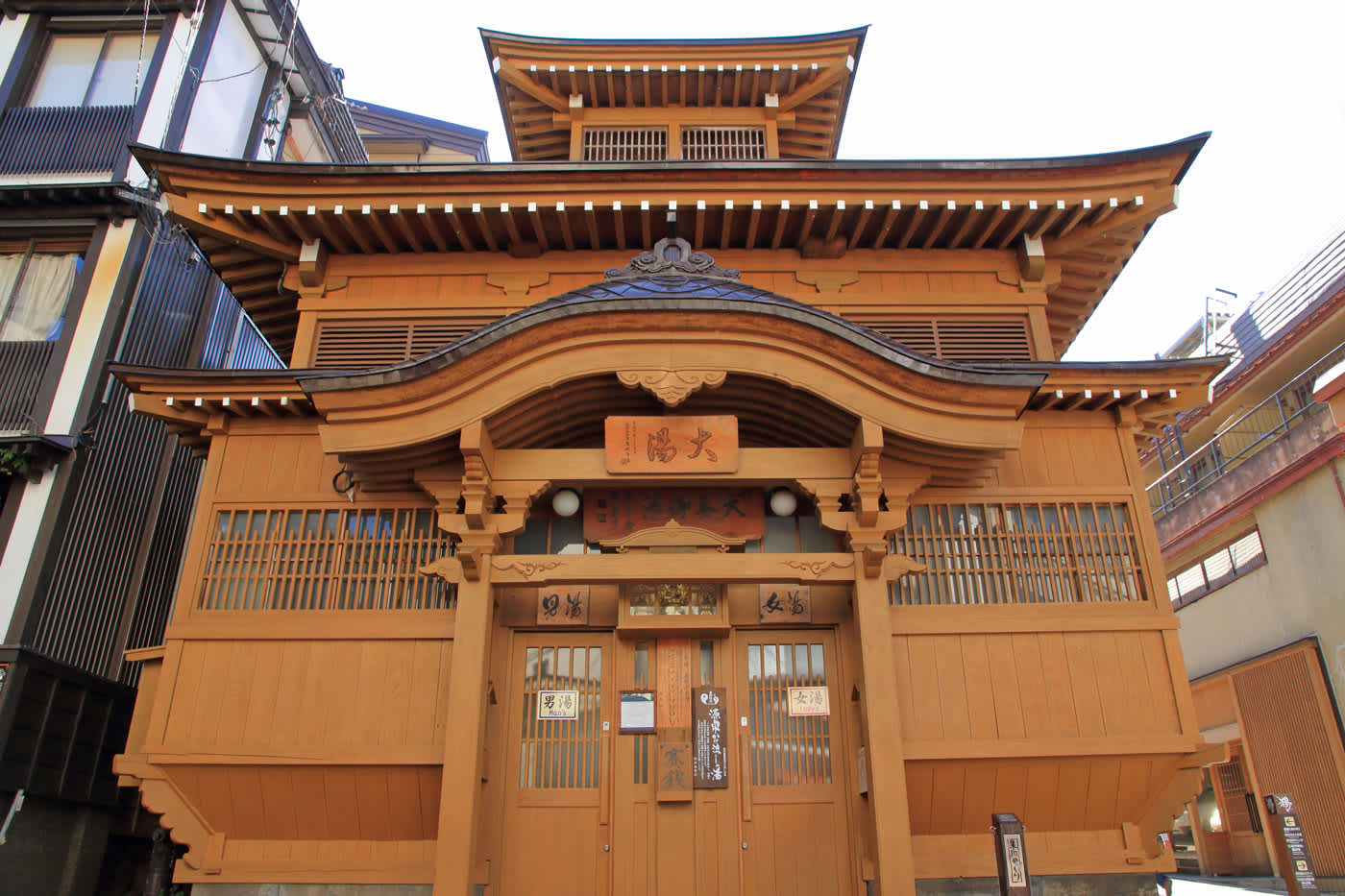
Edo architecture meets healing hot springs at O-YU bathhouse.
One of Nozawa Onsen Village’s biggest attractions is its collection of 13 public bathhouses known as SOTOYU, which are lovingly maintained by local residents and are free for the public to use. All the baths are supplied with a continuous flow of hot spring water from its local natural source.
Nozawa Onsen Village can be accessed by bus from Iiyama Station, which is a stop on the Hokuriku Shinkansen bullet train line that connects Nagano with Tokyo.
Forest Hot Springs and Wildlife Watching in Shiretoko National Park

Exploring the wild landscapes of Shiretoko National Park.
Shiretoko National Park is a vast area of the Shiretoko Peninsula in northeastern Hokkaido, covering almost 390 square kilometers. A haven for wildlife, it’s home to 36 land and 22 marine mammal species including brown bears, orcas, and spotted seals. The park is also a birdwatcher’s paradise, with 285 species of birds, including white-tailed eagles and Steller's sea eagles.
The park's rugged landscape is characterized by the Shiretoko Mountains that run through its center, dramatic cliffs plunging into the Sea of Okhotsk, and vast, unspoiled wilderness.
Popular activities in Shiretoko National Park include wildlife-watching tours, nature walks, and hiking. On the park's eastern coast, visitors can also explore the coastal town of Rausu.
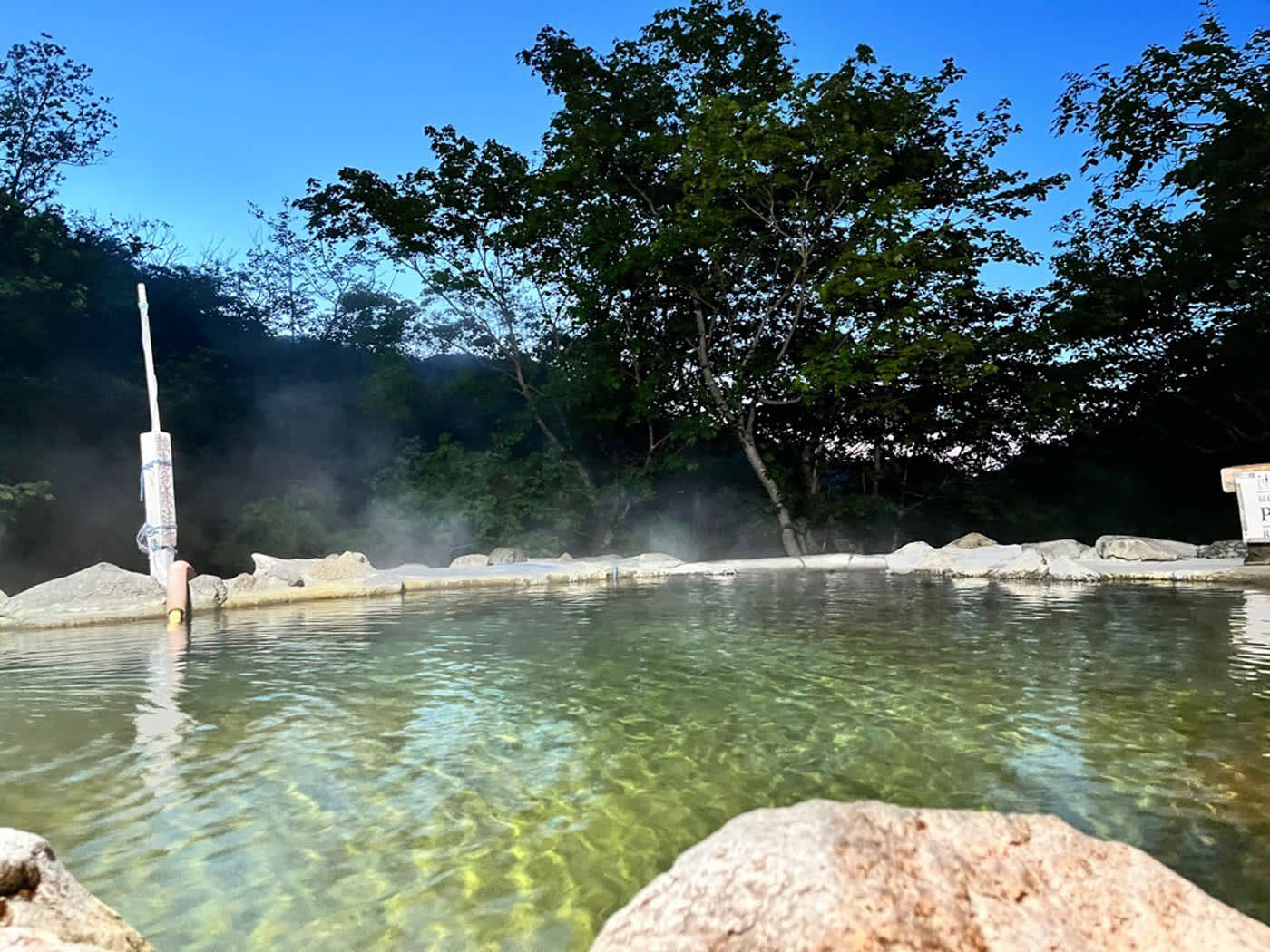
Soak up the beautiful natural surroundings at Kumanoyu hot spring.
With campsites available and several hot springs to visit, Rausu serves as a good base from which to explore the park and its wildlife. The Rausu Onsen Campsite, open from June to September is nestled deep in Shiretoko’s forests, allowing visitors to really appreciate the natural surroundings and peaceful atmosphere. There are also small hotels, inns, and guesthouses in the area for visitors who prefer not to camp.
The public open-air bath "Kumanoyu" is a hidden hot spring where bathing is accessible all year round. Surrounded by forests and the river, there is a separate bath reserved for women, as well as changing areas. The hot spring was originally used as a place where residents visited to help relieve their fatigue, but today visitors from all over Japan seek out this tranquil spot.
The nearby Rausu Geyser, a natural monument of Hokkaido, erupts around once an hour and is also a great stop to visit before or after the hot springs.
Final Reflections – Experiencing Japan’s Natural Water Wonders
Exploring Japan’s national parks through their unique water experiences offers a captivating blend of natural beauty, cultural significance, and outdoor adventure. Whether it’s kayaking along the Kumano River, exploring Lake Chuzenji, or relaxing in the hot springs of Nozawa Onsen Village and Shiretoko National Park, each destination offers a unique perspective on Japan's natural wonders.
Information
Yoshino-Kumano National Park |
|
WEB:https://www.env.go.jp/en/nature/nps/park/yoshino/index.html |
Nikko National Park |
|
WEB:https://www.env.go.jp/en/nature/nps/park/nikko/index.html |
Joshin'etsukogen National Park |
|
WEB:https://www.env.go.jp/en/nature/nps/park/joshinetsu/index.html |
Shiretoko National Park |






















































